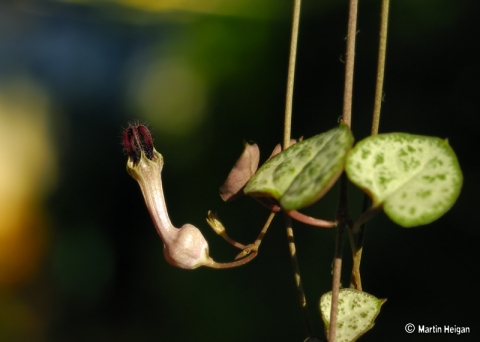Ceropegia linearis
E.Mey.
Apocynaceae
Ceropegia barbertonensis N.E.Br.
Ceropegia caffrorum Schltr.
Ceropegia collaricorona Werderm.
Ceropegia debilis N.E.Br.
Ceropegia euryacme Schltr.
Ceropegia hastata N.E.Br.
Ceropegia leptocarpa Schltr.
Ceropegia schoenlandii N.E.Br.
Ceropegia tenuis N.E.Br.
Ceropegia woodii Schltr.
Common Name:
General Information
Ceropegia linearis is a semi-succulent, climbing plant producing a cluster of slender stems up to 2 metres or more long from a tuberous rootstock that is 20 - 30mm in diameter. The stems are often annual, but can also persist for more than one year - they scramble over the ground or twine into surrounding vegetation for support.
The plant is sometimes harvested from the wild for local medicinal use. It is widely cultivated throughout the world as an ornamental in hanging baskets[
299- Title
- Protabase - Plant Resources of Tropical Africa.
- Publication
-
- Author
-
- Website
- http://www.prota.org
- Publisher
-
- Year
- 0
- ISBN
-
- Description
- An excellent on-line database with detailed information on over 3,200 species of useful plants of Africa.
].
Known Hazards
None known
Botanical References
Range
Southern Africa - Botswana, S. Africa.
Habitat
Rocky outcrops in coastal bush in S. Africa[
].
Properties
| Medicinal Rating |      |
| Other Uses Rating |      |
| Habit | Climber |
| Height | 2.00 m |
| Pollinators | Humming birds |
| Cultivation Status | Ornamental, Wild |
Cultivation Details
Succeeds in full sun and in light shade. Requires a well-drained soil[[
385- Title
- Bihrmann's Caudiciforms
- Publication
-
- Author
-
- Website
- http://www.bihrmann.com/caudiciforms/
- Publisher
-
- Year
- 0
- ISBN
-
- Description
- An internet site giving information on caudiciform plants (plants with swollen stem bases such as the Baobab tree, cycads and many succulents). Excellent photos, usually of cultivated plants in pots.
]. The amount of moisture available to the plant determines the colour and thickness of the leaves. Plants kept moist have thin, solid green leaves. When it gets drier, the leaves thicken and get their silvery coating - this is probably used to reflect some of the sun to decrease temperature stress[
423- Title
- Desert Tropicals
- Publication
-
- Author
-
- Website
- http://www.desert-tropicals.com/
- Publisher
-
- Year
- 0
- ISBN
-
- Description
- The main focus of the site is succulent plants, but it also contains information on a wide range of other species. Usually at least one good photograph, plus basic information about the plant and its cultivation.
].
Edible Uses
None known
Medicinal
A decoction of leafy stems is taken to treat chest complaints[
299- Title
- Protabase - Plant Resources of Tropical Africa.
- Publication
-
- Author
-
- Website
- http://www.prota.org
- Publisher
-
- Year
- 0
- ISBN
-
- Description
- An excellent on-line database with detailed information on over 3,200 species of useful plants of Africa.
].
Agroforestry Uses:
The stem tubers are used as stock for grafting difficult stem succulents[
299- Title
- Protabase - Plant Resources of Tropical Africa.
- Publication
-
- Author
-
- Website
- http://www.prota.org
- Publisher
-
- Year
- 0
- ISBN
-
- Description
- An excellent on-line database with detailed information on over 3,200 species of useful plants of Africa.
]..
Other Uses
None known
Propagation
Seed - best sown as soon as it is ripe[
423- Title
- Desert Tropicals
- Publication
-
- Author
-
- Website
- http://www.desert-tropicals.com/
- Publisher
-
- Year
- 0
- ISBN
-
- Description
- The main focus of the site is succulent plants, but it also contains information on a wide range of other species. Usually at least one good photograph, plus basic information about the plant and its cultivation.
].
Division of the small tubers which form along the stem at the leaf bases. These tubers can be planted to produce new vines - just press them into the soil, and keep moist but not wet. The tubers root more quickly if they are still attached to the mother plant. Once rooted and growing, the new plant can be easily severed from the parent.
If you have any useful information about this plant, please leave a comment. Comments have to be approved before they are shown here.





 Useful Tropical Plants Database 2014 by
Ken Fern,
web interface by
Ajna Fern
with help from
Richard Morris.
Useful Tropical Plants Database 2014 by
Ken Fern,
web interface by
Ajna Fern
with help from
Richard Morris.